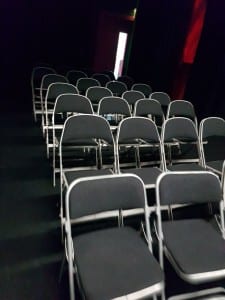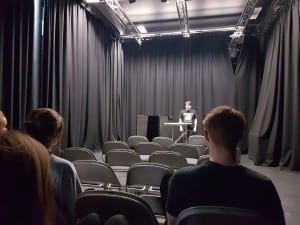After doing my rehearsal on Tuesday, I began to think about how the opening would work. Indeed, whilst what I had was interesting, I felt that I needed a pre-set for the audience to experience in which, when entering the space, they would feel overwhelmed about the event. Similarly, they would feel how I felt on the day when I heard the news that the incident had occurred and the day after when I found out it was my friend involved in the incident.
Part of the reason I felt this pre-set is important is because they need to know about the incident and I would rather give them the context of that situation by showing them what happened rather than telling them. So, I started thinking about ideas and how this may work. When beginning the pre-set, I knew I wanted to use The Smiler music used at Alton Towers as when listening to it, there was something quite horrible concerning the music. Indeed, in the song, there is a heavy bass sound that is used as the beat of the song as if it is meant to be oppressive. Later, there is the sound of people laughing in a sinister manner and a we can hear the scream of a girl as if she is having fun (IMAscoregermany, 2013).
Personally, when listening to the song, I found this a bit darker than what was expected. Indeed, whilst the concept of the ride, as stated by TowersStreet.com, is based on the concept of Marmalisation” which is “a process intended to instill a sense of social compliance through constant smiling” and is based on the idea that the guests are social experiments, there was something about the music that made it have a double meaning (Towers Street, 2018). Indeed, the music itself reminds me more now about the incident and can be seen as a scary reminder of the day about a set of people intending to have fun and being part of a tragic event.
However, when messing about on a laptop and browsing about to get an idea of the event, I decided to look at the news broadcasts made and found a really interesting set of them. From there, I decided to compile them underneath the music and found it to be scarier as the music was an undertone under the piece and I felt that this could be used when the audience enters. In the next couple of weeks, I am intending to mix this together in the Media Building and I hope that this will show its big effect. Whilst I cannot mix it now, here are the clips I am intending to use in this video under The Smiler music.
(IMAscoregermany, 2013)
(Good Morning Britain, 2015).
(BBC News, 2015).
(Sky News, 2015).
(ThorpeLT, 2015).
These are just a few of the videos that I’m intending on using. From this, I am hoping this may overwhelm the audience with the seriousness of the incident and also how one incident isn’t as forgettable as it is to others.
However, in furthering this idea of overwhelming the audience, I am intending to also do something else. As mentioned before, I want to explore the idea of using tape to represent something. However, I am very aware that this will limit the amount of people who wish to view the show. Therefore, I am intending to also use tape again to represent the queue and people will be able to voyeuristically watch it from the experience of the queue. By doing this, it will allow them to get a sense of the incident and how exposed I felt when I heard the news. Plus, I want to explore the idea of becoming a ride attendant and seating the audience in the rows as if they are actually going on the ride. Therefore, the message could feel more heartfelt about the idea of people looking forward to a day at the park and going out for a good time and instead coming back with horrible memories.
Works Cited:
BBC News (2015) Alton Towers boss: ‘We are devastated by what happened’ BBC News. Available from https://www.youtube.com/watch?v=Z5ZXE6GIYXQ [accessed 29 March 2018].
Good Morning Britain (2015) Alton Towers Smiler Crash – Good Morning Britain. Available from https://www.youtube.com/watch?v=r5VxuRa_WBc [accessed 29 March 2018].
IMAscoregermany (2013) The Smiler Soundtrack [official]. Available from https://www.youtube.com/results?search_query=the+smiler+music [accessed 29 March 2018].
Sky News (2015) Full Interview With Alton Towers Boss After Rollercoaster Crash. Available from https://www.youtube.com/watch?v=kke3h2UeH3I [accessed 29 March 2018].
ThorpeLT (2015) Smiler Accident at Alton Towers (LONGER VERSION) 02/06/2015. Available from https://www.youtube.com/watch?v=Ems1fgKysVQ [accessed 29 March 2018].
Towers Street (2018) The Smiler. Available from https://towersstreet.com/theme-park/ride/the-smiler/ [accessed 29 March 2018].






